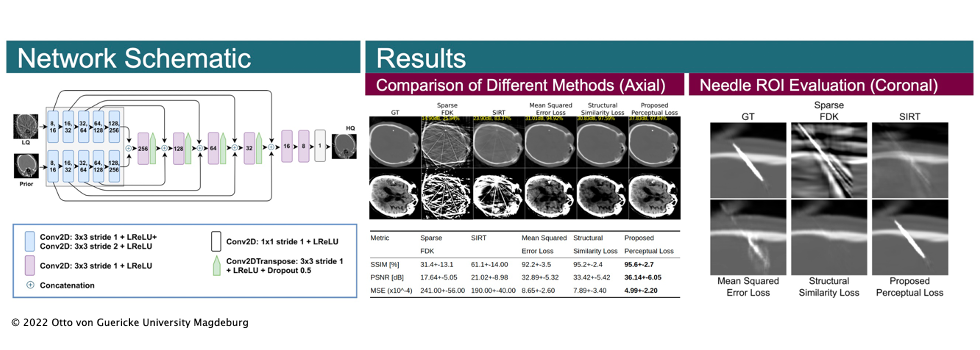Model-based reconstruction methods for CT perfusion imaging
...
M1.3 | Use of prior knowledge in CT reconstruction
Funding period: Jul 2017 to Dec 2021
Researchers: Suhita Ghosh, Domenico Iuso
Wrap-up
Keywords: computed tomography, image-guided interventions, sparse-view CT, interventional CT, deep learning
Background:
The C-arm Cone-Beam Computed Tomography (CBCT) plays a major role in interventions and radiotherapy. However, the slow data acquisition and high dose hinder its predominance in the clinical routine. To overcome the high-dose issue, various protocols such as low-dose and sparse-view have been proposed. In low-dose, a much lower tube voltage or current is used, leading to acquisition of noisy raw-data or projections. In sparse-sampled method, a subset of projections is acquired over increased angular steps. Applying the standard reconstruction algorithms to datasets obtained from such protocols results in volumes with severe streaking artifacts. Further, the presence of surgical instruments worsens the quality and make the reconstructions clinically useless.
Objective:
The objective of the project is to use prior knowledge to enhance the quality of projections or reconstructions. One of the examples of prior knowledge is the high-quality pre-operative CT scans, which are usually acquired for diagnosis and Intervention planning, which contain the required high-resolution details of the body part.
Methods:
1. Incorporation of FDK reconstructions from sparse-sampled dataset as prior, and use a DL architecture VQ-VAE aided with perceptual losses to produce artifact-free CBCT images.
2. Incorporation of preplanning CT and sparse-sampled FDK reconstruction as prior to improve on the method 1, which leads to better soft-tissue contrast and high-resolution image.
Results:
The methods proposed led to production of artifact-free and high-resolution images, which were sufficient for the interventions, confirmed by the user study done with the radiologists. The idea can be further applied to online radiotherapy, where the planning is done based on planning CT and noisier CBCT is used during the dose-delivery.
Conclusions:
In the project, we proposed methods which used DL architecture which can incorporate the sparse-sampled FDK reconstruction and the planning CT as the prior knowledge to produce data-consistent interventional reconstructions of the same subject from sparse-sampled datasets. The sparse-sampled dataset was reconstructed using only 3.6% of the total projections (13 out of 360). The incorporation of planning CT facilitates the network to improve the soft-tissue contrast of the head reconstructions, which mightbe helpful for tracking the lesion boundary during interventions.The method does not require the interventional and planning scans to be exactly registered, unlike the existing conventional iterative approaches. We also proposed perception-aware losses for the task, which further helped the model to capture the pertinent representationsfrom both planning and interventional scans. Since planning CTs are always available before any intervention, the proposed method does not require any extra data acquisition or change in the existing interventional plan. As future work, the reconstruction quality of the needle can be improved by incorporating the geometry prior of the instrument in the network, and evaluation with multiple inserted instruments. We also performed a clinically relevant user-study, where the domain experts validated the usefulness of the improved reconstructions.
Originality:
Proposed a novel architecture incorporating planning CT as prior and perceptual losses for the task.









